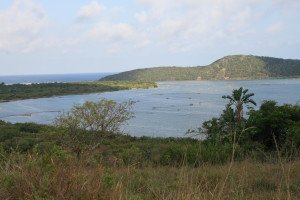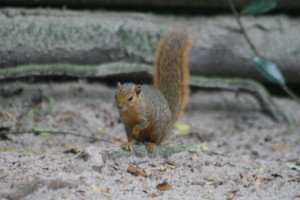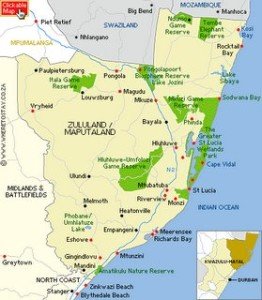
Crooks Corner – the confluence of the Luvuvhu and Limpopo Rivers
Crooks Corner, which provides an amazing diversity of birds thanks to the combination of tropical riverine forest and sandveld, is one of those mystical, frontier places where you expect anything to turn up and is the north-eastern tip of Kruger National Park, at the end of the S63 Luvuvhu River Drive.
The confluence of the Limpopo and Luvuvhu rivers is called Crooks Corner because it was here, where the borders of South Africa, Zimbabwe and Mozambique meet, that scoundrels and rogues of a century ago would hide out and merely skip across the sandbars into another country when justice came a-looking.
There’s always something interesting in the dense forest or along the rivers at Crooks Corner, but the surrounding area is also great for birds and having that sense of expectation that something unusual is lurking just around the next bend is always exciting.
Heading back from Crooks Corner, away from the rivers in the direction of the Pafuri Border Gate with Mozambique, the road goes through an area of open Lala Palm savanna and then into Mopane forest that is fringed by Fever Trees.
Some little pools had formed below these Fever Trees which I initially drove past. But a hunch – you must always follow them! – made me go back and study the inundated areas more closely.
There were some baboons foraging on the ground and there, perched on a stick rising about a metre above the ground, was the distinct shape of a tiny heron.
Closer examination revealed the scarce Dwarf Bittern – only the second one I’ve seen. (The first was at Ndumo, also on the edge of a quiet pool in a well-wooded area).
The Dwarf Bittern is famous for its nomadic lifestyle, arriving in a place after good rains have led to local flooding, having an uncanny ability to find such areas within days of them being inundated.
It’s an enigmatic, secretive bird – partly nocturnal – and a much sought-after but seldom-seen tropical visitor.
Being mid-January, there were plenty of other pools scattered around the sandveld and the sweetveld grasslands on basalt, and just before the S63 Luvuvhu River Drive, Yellowbilled and White Storks, Water Dikkop and Little Bee-Eater were congregated around the water-filled depressions.
Turning on to the S63, the hundreds of Whitebacked Vultures either in the trees or circling in the sky soon became evident. There were 66 in two adjacent dead trees alone, with a few Lappetfaced Vultures among them.
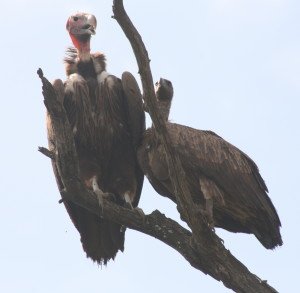
Lappetfaced Vulture on the S63
Longtailed Starlings scratching around, Whitefronted Bee-Eaters swooping off the banks of the river, the odd Whitecrowned Plover on the sandbanks and Greenbacked Heron are the other typical birds of the S63, while a juvenile African Hawk Eagle was flying above the riverine forest.
The grassland around the Lala Palm savanna boasted Whitewinged Widow and a Steelblue Widowfinch was in a Fever Tree on the fringes of the forest, where a group of stately Ground Hornbill were strolling along and a Gymnogene was quartering nearby.
The viewpoint at Crooks Corner offered up Pied Kingfisher and Greenshank, while a Giant Kingfisher was hunting in front of the Pafuri picnic site and a Great White Egret was in the Luvuvhu River. Looking over the river from the main bridge, Rock Martin (and not Brownthroated as you’d expect over water), Little Swift and Wiretailed Swallow were all zooming about, while a Tropical Boubou was on the bank.
The beautiful Melba Finch was in the Acacia thickets as I was leaving Pafuri, the road back to Punda Maria passing through undulating grasslands studded with Baobabs, where all sorts of interesting sightings have been made.
Klopperfontein is always worth visiting and there was a solitary Hippopotamus lying in the dam, while a male Knob-billed Duck and a younger bloke had some territorial skirmishes. Ruff, Redbilled Teal and African Jacana were the other waterbirds present, while European Roller, Swainson’s Francolin, European Bee-Eater, Longtailed Shrike, Pintailed Whydah and Redbacked Shrike are common in the grassland around the dam and drift.
The Amur Falcon is the most common raptor in this habitat and one was sitting quite low down doing some serious maintenance on its heavily-barred tail.
A pair of Whiteheaded Vulture flew overhead and Wahlberg’s Eagle was also patrolling around, but the most fascinating hunter in action was a European Cuckoo sitting on top of a low shrub. It somehow spotted a caterpillar at 90° from it, about five metres away, and immediately swooped on to it. From there it flew briefly into a tree to devour its favourite food before making another sortie on to some rocks and boulders to catch another caterpillar. For a normally shy bird, this was a wonderful sighting.
The H1-8 tar road goes through open savanna grassland with stunted Mopane and is good for raptors, with Steppe Buzzard and Brown Snake Eagle prominent on this occasion. A Striped Cuckoo also posed beautifully.
Heading back towards Punda Maria on the H13-1 takes one through mature Mopane forest and Purple Roller and a very confusing juvenile Blackchested Snake Eagle on top of a dead tree were seen. A small flock of Redbilled Helmetshrike flew into a Tree Mopane making their typical growling calls.
There are also patches of mixed woodland along the H13-1 and seemingly in the middle of this forest stood a gorgeous Saddlebilled Stork on an exposed branch. There must have been a spruit nearby, and the threatened member of the Avian Big Six looked mildly embarrassed by how beautiful it was with its combination of black, white, red and yellow.

Saddlebilled Stork up a tree!
Groundscraper Thrush was another bird which I did not expect to see high up on top of a dead tree, but perhaps the lack of short grass below forced it up into the heavens.
A Bennett’s Woodpecker and an African Hoopoe were together at a dead log, the Woodpecker on top and the Hoopoe at ground level.

A friendly female Bushbuck
Two lovely female bushbuck welcomed me back to camp after an idyllic day and Chinspot Batis, House Martin, Bateleur, Grey Hornbill, Blackbacked Puffback and Greybacked Camaroptera (on the Flycatcher trail behind the reception) are easily seen at Punda Maria, one of the best bird-watching camps in Kruger, an island of sandveld within the sea of Mopane. The camp also has a waterhole just outside the fence which has a marvellous hide overlooking it and Hamerkop, Marabou Stork, Bronze Mannikin and Common Waxbill (both feeding on the seeds of the rank vegetation around the water) were there, along with plenty of Buffalo, a few Elephant and some antelope.
The beautiful Gumbandebvu Hills and their magnificent sandveld woodlands surround Punda Maria and provide great birding. Driving around close to camp provided a flock of 15 Brownheaded Parrot and then numerous others of this threatened gem, indicating that many of the wonderful trees in the area were probably fruiting.
One of the big herds of Buffalo around Punda Maria was enjoying a marvellous mudbath – one individual was having such an awesome spa-day that it had all four feet in the air and was bellowing like a Lion!
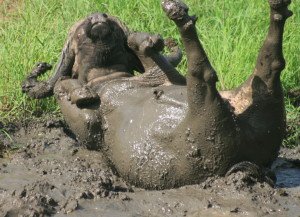
The Buffalo having a wonderful spa-day in the mud!
Redbilled and Yellowbilled Oxpeckers were together with this herd, with the scarcer Yellowbilled tending to be on the young Buffalo and the Redbilled on the adults.
Redbilled Hornbill, Greater Kudu, Plumcoloured Starling, Nyala, Carmine Bee-Eater (using the telephone line in front of the staff quarters), and Blackheaded Oriole are also inhabitants of this beautiful area, which is most effectively explored by taking the circular Mahonie Loop (S99), one of my absolute favourite drives in Kruger.
All sorts of exotic calls ring out from the broadleafed woodland and a Whitebrowed Scrub Robin was on top of a tree, calling away, while a Jacobin Cuckoo was a bit more shy at the Witsand waterhole. Black Widowfinch, Green Pigeon, Browncrowned Tchagra, Paradise Flycatcher and Marabou Stork were also spotted.
The Dzundzwini Loop south-east of Punda Maria (S58) provides a break from the tall stands of Mopane with more marvellous mixed woodland.
A beautiful Woodland Kingfisher was sitting on a low shrub, unusually for a bird that is normally perched on trees, while another tropical intra-African migrant, the equally spectacular Broadbilled Roller, was up in the high branches as one would expect. Continuing the theme of weird birding pairs, a Crested Francolin was sitting in a bush with a whole bunch of Grey Louries!
Waterbuck and Tawny Eagle were present at the Dzundzwini Spring, marked by a big Sausage Tree at the base of the hill.
The H1-7 tar road that takes one from Punda Maria to Shingwedzi goes through a mixture of palm savanna and open Mopane shrubveld and a Blackcrowned Tchagra was singing beautifully, as only they can, while just a single Monotonous Lark was also calling away, perhaps trying to hail his mates.
The call of the Tawnyflanked Prinia was also heard all around the wetlands of the Shisha River System but a sighting was proving elusive until I finally spotted one in a Mopane tree.
Thulamila Koppie is a short drive from Punda Maria camp and again offers a mixture of woodland trees. The road to the top of the koppie – at 604m – is quite steep but it had been freshly graded on this day and Jameson’s Firefinch was amongst other finches and waxbills enjoying what had been thrown up by the maintenance team.
Sightings list
Elephant
Buffalo
House Martin
Bateleur
Grey Hornbill
Hamerkop
Rattling Cisticola
European Swallow
Brownheaded Parrot
Grey Lourie
Natal Francolin
Slender Mongoose
Forktailed Drongo
Yellowbilled Oxpecker
Redbilled Oxpecker
Greater Blue-Eared Starling
Redbilled Hornbill
Warthog
Cape Turtle Dove
Impala
Greater Kudu
Plumcoloured Starling
Nyala
Blackheaded Oriole
Plains Zebra
Common Rough-Scaled Plated Lizard
European Roller
Swainson’s Francolin
European Bee-Eater
Amur Falcon
Longtailed Shrike
Pintailed Whydah
Whiteheaded Vulture
Southern Masked Weaver
European Cuckoo
Redbilled Teal
Blacksmith Plover
Hippopotamus
African Fish Eagle
Knob-billed Duck
Grey Heron
Marsh Terrapin
Chacma Baboon
Wahlberg’s Eagle
Common Moorhen
African Jacana
Egyptian Goose
Redbacked Shrike
Laughing Dove
Steenbok
Blue Wildebeest
Cinnamonbreasted Rock Bunting
Steppe Buzzard
Brown Snake Eagle
Purple Roller
Blackchested Snake Eagle
Redbilled Helmetshrike
Saddlebilled Stork
Bushbuck
Chinspot Batis
Southern Greyheaded Sparrow
Spotted Flycatcher
Striped Skink
Blackeyed Bulbul
Carmine Bee-Eater
Lilacbreasted Roller
Southern Yellowbilled Hornbill
Giraffe
White Helmetshrike
Groundscraper Thrush
Arrowmarked Babbler
African Hoopoe
Bennett’s Woodpecker
Redbilled Buffalo Weaver
Tree Squirrel
Woodland Kingfisher
Broadbilled Roller
Crested Francolin
Emeraldspotted Wood Dove
Redbilled Woodhoopoe
Whitebacked Vulture
Moreau’s Tropical House Gecko
Blackbacked Puffback
Brownhooded Kingfisher
Whitebrowed Scrub Robin
Yellowfronted Canary
Jacobin Cuckoo
Black Widowfinch
Green Pigeon
Browncrowned Tchagra
Paradise Flycatcher
Whitebellied Sunbird
Blue Waxbill
Marabou Stork
Bronze Mannikin
Common Waxbill
Vervet Monkey
Waterbuck
Tawny Eagle
Blackcrowned Tchagra
Tawnyflanked Prinia
Monotonous Lark
Crested Barbet
Striped Cuckoo
Longbilled Crombec
Water Dikkop
Little Bee-Eater
Yellowbilled Stork
Yellowbilled Kite
White Stork
Lesser Striped Swallow
Lappetfaced Vulture
Redeyed Dove
Longtailed Starling
Whitefronted Bee-Eater
Redbilled Quelea
Whitecrowned Plover
African Pied Wagtail
Common Sandpiper
African Hawk Eagle
Greenbacked Heron
Speckled Mousebird
Diederick Cuckoo
Whitewinged Widow
Nile Crocodile
Gymnogene
Hadeda Ibis
Threebanded Plover
Steelblue Widowfinch
Ground Hornbill
Pied Kingfisher
Greenshank
Dwarf Bittern
Giant Kingfisher
Great White Egret
Melba Finch
Leopard Tortoise
Ruff
Helmeted Guineafowl
Jameson’s Firefinch
Van Son’s Thicktoed Gecko
Burchell’s Coucal
Greybacked Camaroptera
Whitefaced Duck
Rock Martin
Little Swift
Wiretailed Swallow
Tropical Boubou
